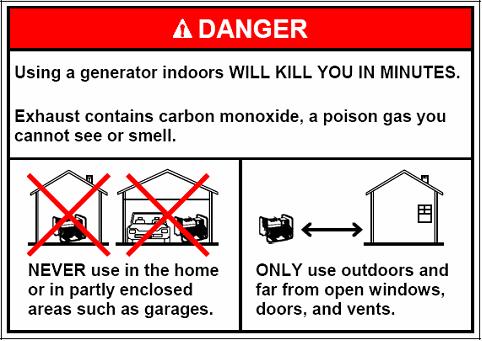During Hurricane Preparedness Week, the U.S. Consumer Product Safety Commission (CPSC) is urging consumers to take steps to safeguard their families when using a portable generator. If your power is out due to a hurricane, or for any reason, operating your generator safely can mean the difference between life and death.
The exhaust from generators contains poisonous carbon monoxide, an odorless, invisible killer. "The amount of carbon monoxide from one generator is equivalent to hundreds of idling cars," said CPSC Chairman Hal Stratton. "Carbon monoxide from a portable generator can kill you and your family in minutes."
In 2005, at least 55 people died from carbon monoxide poisoning associated with portable generators. The aftermath of last year's four major hurricanes resulted in a majority (28) of those deaths.
CPSC urges consumers to follow these safety tips when operating a portable generator after a storm or other event that has caused a power outage.
- Never use a portable generator indoors, including in your home, garage, basement, crawlspace, shed or partially-enclosed area – even with ventilation. Opening doors and windows or using fans will not prevent CO buildup in the home.
- Only use a portable generator outdoors in a dry area far away from doors, windows and vents that can allow CO to come indoors.
- Install battery-operated CO alarms or plug-in CO alarms with battery back-up in your home. Test the alarms frequently and replace dead batteries.
- Get to fresh air right away if you start to feel dizzy or weak. The CO from generators can rapidly lead to full incapacitation and death.
- Plug appliances into a heavy duty, outdoor-rated extension cords and plug the cords into the generator.
- If you are concerned about theft, secure your generator outside.
To reach consumers with this lifesaving information, CPSC has developed new warning labels for newly manufactured generators. Underwriters Laboratories (UL) has adopted the same labels in its new procedure for certifying portable generators. Any manufacturer that wants the UL certification will have to place the new warning label on its generators. Generators must also have ground fault circuit interrupters to prevent electrocution if they get wet.
CPSC Chairman Stratton said, "If we can keep people from using a generator indoors, in a partially-enclosed area or anywhere close to their home, these labels have done their job."
Last fall, Stratton directed CPSC staff to undertake a comprehensive safety review of portable generators. That review is ongoing.

About the U.S. CPSC
The U.S. Consumer Product Safety Commission (CPSC) is charged with protecting the public from unreasonable risk of injury or death associated with the use of thousands of types of consumer products. Deaths, injuries, and property damage from consumer product-related incidents cost the nation more than $1 trillion annually. CPSC's work to ensure the safety of consumer products has contributed to a decline in the rate of injuries associated with consumer products over the past 50 years.
Federal law prohibits any person from selling products subject to a Commission ordered recall or a voluntary recall undertaken in consultation with the CPSC.
For lifesaving information:
- Visit CPSC.gov.
- Sign up to receive our e-mail alerts.
- Follow us on Facebook, Instagram @USCPSC and Twitter @USCPSC.
- Report a dangerous product or a product-related injury on www.SaferProducts.gov.
- Call CPSC’s Hotline at 800-638-2772 (TTY 301-595-7054).
- Contact a media specialist.
Please use the below phone number for all media requests.
Phone: (301) 504-7908
Spanish: (301) 504-7800
